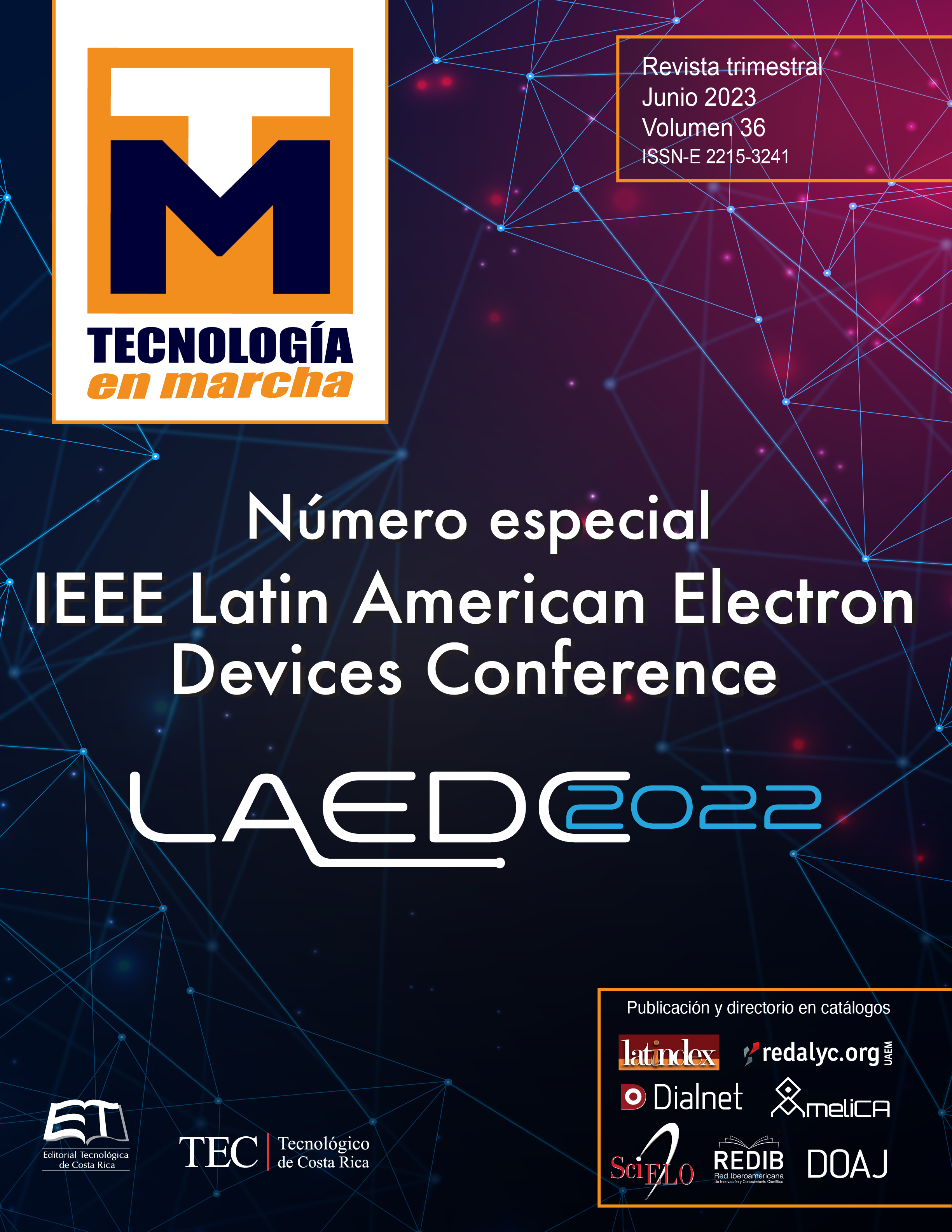Analysis of the degradation of highefficiency encapsulated PM6:Y7based Photovoltaic Cells
Main Article Content
Abstract
In this work, we report a degradation study of high-efficiency conventional polymer solar cells (PSCs). The high performance of the PM6:Y7-based device is achieved with a power conversion efficiency (PCE) of up to 15.64% in the first measurement. The article describes the results of the measurements and analysis of the degradation process. The electrical parameters during the degradation process were extracted from the current density – voltage characteristics curves (J–V) under light and dark conditions. Were observed the specific parameters of the selected cells: open-circuit voltage (VOC), short circuit current density (JSC), fill factor (FF), PCE, series (RS), and shunt (RSH) resistance values The PCE of the device decreased down to 64% of the initial PCE after 1056 h.
Article Details

This work is licensed under a Creative Commons Attribution-NonCommercial-NoDerivatives 4.0 International License.
Los autores conservan los derechos de autor y ceden a la revista el derecho de la primera publicación y pueda editarlo, reproducirlo, distribuirlo, exhibirlo y comunicarlo en el país y en el extranjero mediante medios impresos y electrónicos. Asimismo, asumen el compromiso sobre cualquier litigio o reclamación relacionada con derechos de propiedad intelectual, exonerando de responsabilidad a la Editorial Tecnológica de Costa Rica. Además, se establece que los autores pueden realizar otros acuerdos contractuales independientes y adicionales para la distribución no exclusiva de la versión del artículo publicado en esta revista (p. ej., incluirlo en un repositorio institucional o publicarlo en un libro) siempre que indiquen claramente que el trabajo se publicó por primera vez en esta revista.
References
A. A. A. Torimtubun, J. G. Sánchez, J. Pallarès, and L. F. Marsal, “Photostability Study of Inverted Polymer Solar Cells Under AM 1.5G and LED Illumination via Impedance Spectroscopy” Electron Devices Society, 2021, doi:10.1109/JEDS.2021.3052719.
E. Moustafa, J. G. Sánchez, L. F. Marsal, and J. Pallarès, “Stability Enhancement of High-Performance Inverted Polymer Solar Cells Using ZnO Electron Interfacial Layer Deposited by Intermittent Spray Pyrolysis Approach,” ACS Appl. Energy Mater., vol. 4, no. 4, pp. 4099–4111, 2021, doi: 10.1021/acsaem.1c00455.
A. A. A. Torimtubun, M. Méndez, J. G. Sánchez, J. Pallarès, E. Palomares, and L. F. Marsal, “Shelf lifetime analysis of organic solar cells combining frequency and time resolved techniques,” Sustain. Energy Fuels, vol. 5, no. 24, pp. 6498–6508, 2021, doi: 10.1039/D1SE01107C.
M. Ramírez-Como et al., “Small molecule organic solar cells toward improved stability and performance for Indoor Light Harvesting Application,” Sol. Energy Mater. Sol. Cells, vol. 230, no. June, p. 111265, Sep. 2021, doi: 10.1016/j.solmat.2021.111265.
A. Sacramento, M. Ramirez-Como, V. S. Balderrama, S. I. Garduno, M. Estrada, and L. F. Marsal, “Inverted Polymer Solar Cells Using Inkjet Printed ZnO as Electron Transport Layer: Characterization and Degradation Study,” IEEE J. Electron Devices Soc., vol. 8, pp. 413–420, 2020, doi: 10.1109/JEDS.2020.2968001.
M. Ramírez-Como, V. S. Balderrama, A. Sacramento, L. F. Marsal, G. Lastra, and M. Estrada, “Fabrication and characterization of inverted organic PTB7:PC70BM solar cells using Hf-In-ZnO as electron transport layer,” Sol. Energy, vol. 181, pp. 386–395, Mar. 2019, doi: 10.1016/j.solener.2019.02.015.
C. H. Peters et al., “The Mechanism of Burn-in Loss in a High Efficiency Polymer Solar Cell,” Adv. Mater., vol. 24, no. 5, pp. 663–668, Feb. 2012, doi: 10.1002/adma.201103010.
A. V. Kesavan, K. K. Khanum, S. Subbiahraj, and P. C. Ramamurthy, “Evaluation of Polymer Solar Cell Efficiency To Understand the Burn-in Loss,” J. Phys. Chem. C, vol. 123, no. 37, pp. 22699–22705, Sep. 2019, doi: 10.1021/acs.jpcc.9b02584.
J. G. Sánchez, A. A. A. Torimtubun, V. S. Balderrama, M. Estrada, J. Pallares, and L. F. Marsal, “Effects of annealing temperature on the performance of organic solar cells based on polymer: Nonfullerene using V2O5 as HTL,” IEEE J. Electron Devices Soc., vol. 8, pp. 421–428, Oct. 2020.

